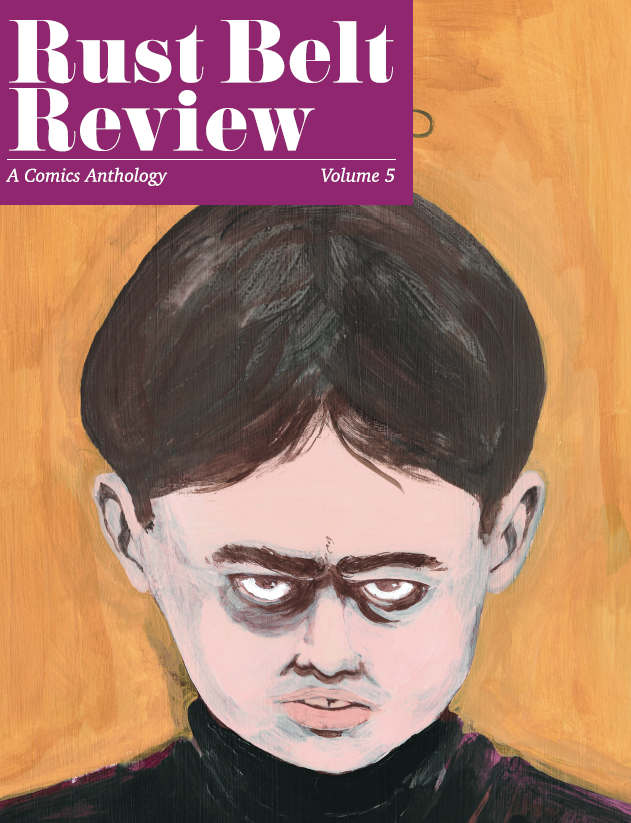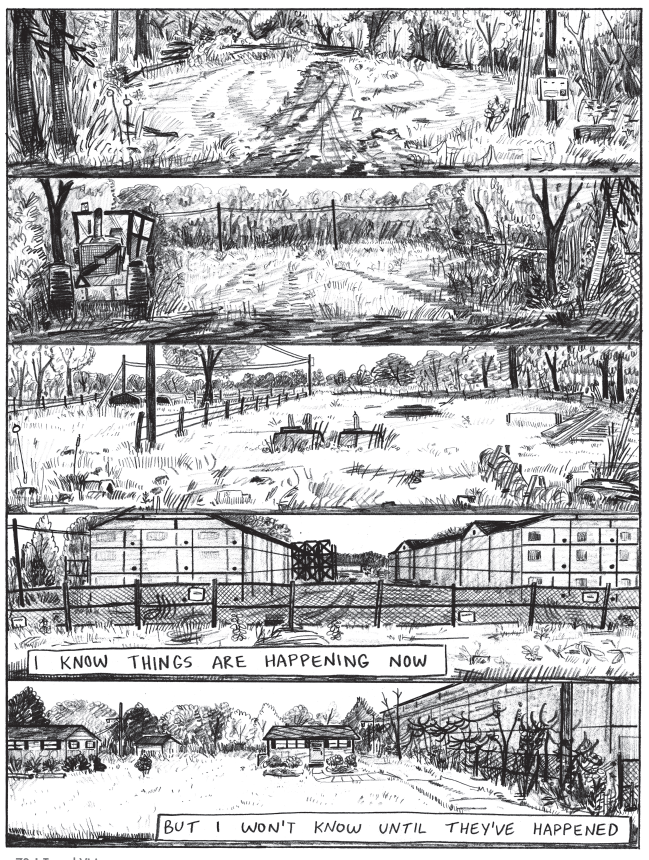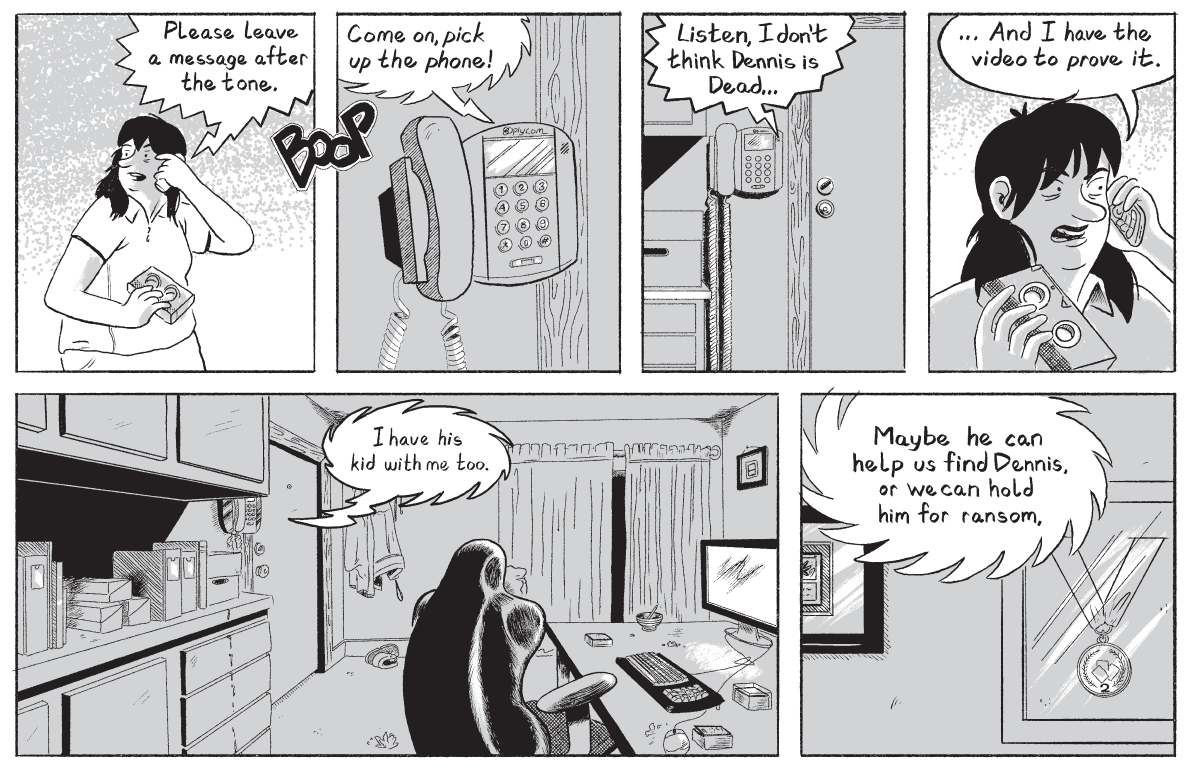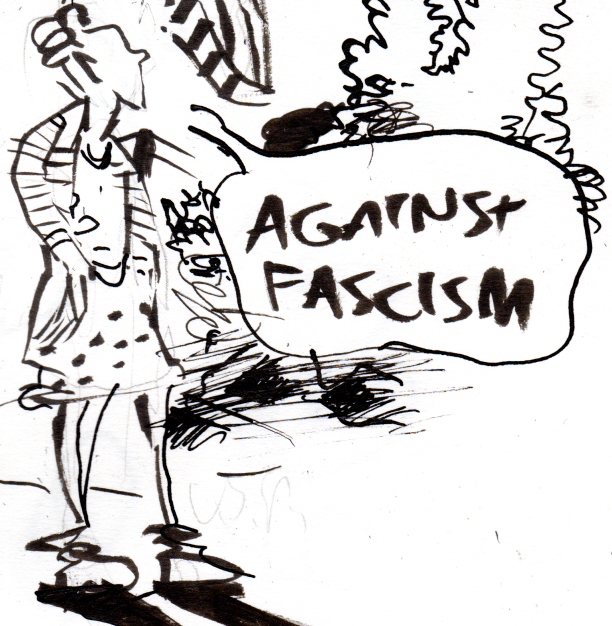
Sean Knickerbocker thought he’d moved on from his Rust Belt comic series once it was compiled into a 2019 book.
“Then I got thinking about it and what the spirit of that comic was,” Knickerbocker told The Comics Journal over Zoom this past May, “and I was like, well, I could bring it back and do new stuff and add other people to it.”
Rust Belt morphed into Rust Belt Review, a large-format anthology of comics, mostly by contributors with a Rust Belt background or sensibility; it began in early 2021, and has just released its fifth volume.
The anthology, a 9.25” x 12” b&w softcover with a spine, is published and edited by Knickerbocker. Frequent contributors include Audra Stang, Alex Nall and Andrew Greenstone, as well as Knickerbocker himself, serializing a new story titled "Best of Three". He sells copies on his website and through about a dozen comic shops.

“I’m a printer by trade,” Knickerbocker said. “I love printing things, making books and that kind of stuff. It takes me so long to make a comic that I don’t really have a lot of opportunities to make books, so I wanted to give myself more opportunities to do that.” David Mazzucchelli’s early '90s anthology series Rubber Blanket, in which Mazzucchelli would run his own work alongside others, served as an early inspiration.
Knickerbocker has worked in book printing for about a dozen years, and has held his current full-time gig at a Minneapolis print shop for roughly six. Every issue of Rust Belt Review is printed where he works. He estimates that producing a run of a single issue costs $2,000, including printing costs and other expenditures, such as buying shipping supplies. He used to print about 300 copies and then do a reprint run, but now he does 500 up front. “Five hundred seems to be a good mark where it’s more than I’m going to need for a while,” he said, “but I can reliably have back stock to sell at shows and other events or have back stock available for future volumes if someone’s just getting on board.”

Knickerbocker estimates putting together a new issue takes about 60 hours of his time, ranging from weeks that demand as little as a few hours to much busier periods leading up to a new issue’s release. The series is profitable, but he’s nonetheless trying to improve sales. Toward the beginning of the pandemic, he did well promoting the series on social media, but has found working within the Instagram algorithm to be an increasingly difficult way to sell books, so he’s been reaching out more to comic shops. Dependable stores for Rust Belt Review include Atomic Books in Baltimore, Copacetic Comics in Pittsburgh, and Gutter Pop Comics in Buffalo.
Contributors receive royalties in addition to copies of the book to sell themselves, according to Knickerbocker. Royalties have been “pretty modest,” but he hopes the increased print run will allow for better royalties for contributors. “It pays for itself pretty quickly, in terms of sales of the books, and then just kind of tapers off after that. I’ve been trying to adjust the numbers a little bit more to make it a little more fruitful for the contributors, because I do want them to get paid.”
The first issue ran 72 pages, then 88 for issue two, then 94, then 100, and now 110 for the latest. The first sold for $10, two through four cost $12.99, and the latest, which includes a removable 12-page full-color minicomic by Pat Rooks, costs $20.
“It’s a beefier issue than the last ones,” Knickerbocker said. “They’re progressively getting thicker and thicker, which I guess is a good thing. I want it to be a venue for a ton of people, that’s the idea. And from the economic standpoint, that makes sense too, to have these thicker books. The difference in cost for a 120-page book versus an 80-page book is very minimal, so it just makes sense to add more pages to it if you can. I’d like to make them bigger as time goes on, but we’ll see.”

Knickerbocker’s serial, "Best of Three", has thematic similarities to his past work, though it is also funnier, with lines like "Commander George, bring me my whippits."
“I wanted to dip my toe into something that seemed intentionally more comedic,” Knickerbocker said. “I wouldn’t describe it necessarily as a comedy, but I wanted to have a little bit more fun with the story.” The plot follows a slacker who comes into a lot of money after his father, a massively successful figure in the Magic: The Gathering scene, passes away. “Coming at it from my lefty politics perspective, it’s a very American type of character. I want to tell an American story about greed in a really pathetic way. So I thought that competitive gaming for Magic: The Gathering would be a funny way to do that.”
Dazzled early on by the heart and simplicity of comics such as Thimble Theatre, Peanuts and Dick Tracy, Knickerbocker developed his art style along similar lines. “I’m never going to be able to draw like Jack Davis or something. It’s not in my wheelhouse. But a simpler style I can certainly do. And it’s also easier for me time-wise to draw in a simpler style, so I’m always trying to pare it down a little bit in terms of making things simpler, because it’s easier to read and I can draw it a little bit faster.”
As for fielding other cartoonists for the anthology, Knickerbocker doesn't require the stories to have anything to do with the Rust Belt, but that connection remains.
“Even now, when I’m saying to people, ‘it doesn’t have to be these kind of stories,’ I think I have a preference for them,” Knickerbocker said. “I seek those out a little bit more, and I think people that are making those kinds of stories seek out this thing I’m doing as well, so I think it’s always going to be there.”

Audra Stang, who lives in the Philadelphia area, has a series in Rust Belt Review called "Tunnel Vision". It connects to storylines from her own self-published series, The Audra Show, and follows a group of young teenage boys and girls exploring a system of tunnels; emotionally, they are on the border separating childhood immaturity from teenage angst. "Tunnel Vision" concludes in the new issue of Rust Belt Review, and there are plans to collect it separately.
Stang told the Journal she was inspired to tell stories of adolescents in tunnels after visiting Lebanon, Pennsylvania, with her boyfriend, and hearing similar stories from his sister. She also wanted to buck the trend of female cartoon characters not having friends, while exploring the more childlike side of being a young teen. Working as a counselor at a summer camp with eighth graders got her thinking about this.
“There were kids who were more interested in texting or more interested in doing their hair, or talking to the boys,” Stang said. “And then a lot of the 14-year-olds just wanted to go down the waterslide over and over again. I would have been a waterslide kid.”

Alex Nall has had several self-contained stories published in Rust Belt Review, all of which take place in a fictional small town in Illinois, inspired by where he grew up. When we spoke by Zoom, he panned the camera to a detailed map and a comprehensive list of residents for this imaginary place.
“I’m really interested in how these townspeople, their environment, their social status, their family histories, kind of collide and enforce the decisions that they make, for better or worse,” Nall said. He loves working with Knickerbocker and contributing to Rust Belt Review. “He's honestly one of the best editors I’ve worked with. I think he curates a really great collection of cartoonists and work to share… he communicates well. He gives a lot of freedom for not only the type of stories that can be told, but, I mean-- I think one of the first ones I sent him, ‘License to Kill’, is like 23 pages long, and he was like, ‘Yeah, that’s fine, it’s great. The more the better.’”

While there’s a lot of work to producing the anthology, Knickerbocker describes his work on it as “pretty laid back.” Developing a template and format, consistently used issue to issue, makes it a lot easier. However, sometimes his passion and ambition gets the better of him, and he ends up adding a gimmick that makes for a lot more work, such as that full color minicomic in issue five.
“At the time I was really excited about it, but now I’m actually gluing them into the books, and I’m like, ‘why do I keep doing this to myself?’” Knickerbocker recalled. “And I think, it’s just like, from making minicomics for so long, there’s just something really satisfying about doing it for a hundred or 200 copies, and it’s like, ‘oh, that’s really fun.’
“But then you start doing it for 500 copies, and the novelty goes away, and then you start thinking, ‘I should really be drawing comics or spending time with my daughter,’ you know?” he said, laughing. “‘There are more important things in the world than gluing a book into another book.’”






